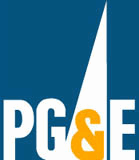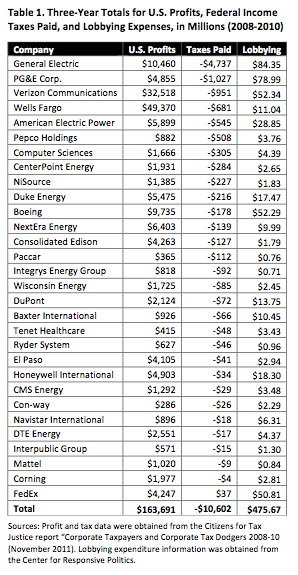PG&E
|
Learn more about corporations VOTING to rewrite our laws. |
|
Learn more from the Center for Media and Democracy's research on climate change. |
| Type | Public (NYSE: PCG) |
|---|---|
| Headquarters | 77 Beale St. San Francisco, CA 94105 |
| Area served | CA |
| Key people | Peter A. Darbee, CEO |
| Industry | Electric Producer & Utility Natural Gas Utility |
| Products | Electricity, Natural Gas |
| Revenue | $13.2 billion (2007)[1] |
| Net income | ▲ $1.01 billion (2007)[1] |
| Employees | 20,050 (2007) |
| Subsidiaries | Pacific Gas and Electric Company |
| Website | PGECorp.com |
The Pacific Gas and Electric Company (PG&E) is the utility that provides natural gas and electricity to most of Northern California. The southern part of the state is generally served by Southern California Edison for power and natural gas from Southern California Gas. PG&E was founded in 1905 and is currently headquartered in the Pacific Gas & Electric Building in San Francisco.
Contents
- 1 Negative Tax Rate and Lobbying
- 2 Ties to the American Legislative Exchange Council (ALEC)
- 3 Political Contributions and Lobbying
- 4 PG&E leaves Chamber of Commerce over climate policy
- 5 SmartMeter controversy
- 6 Pipeline explosion
- 7 Compensation
- 8 Power portfolio
- 9 Existing coal-fired power plants
- 10 Resources
Negative Tax Rate and Lobbying
A 2011 analysis by Citizens for Tax Justice and the Institute on Taxation and Economic Policy, "Corporate Taxpayers & Corporate Tax Dodgers: 2008-10" found dozens of companies, including fossil fuels, used tax breaks and various tax dodging methods to have a negative tax balance between 2008 and 2010, while making billions in profits. The study found 32 companies in the fossil-fuel industry -- such as Peabody Energy, ConEd, and PG&E -- transformed a tax responsibility of $17.3 billion on $49.4 billion in pretax profits into a tax benefit of $6.5 billion, for a net gain of $24 billion.
The companies that paid no tax for at least one year between 2008 and 2010 are the utilities Ameren, American Electric Power, CenterPoint Energy, CMS Energy, Consolidated Edison, DTE Energy, Duke Energy, Entergy, FirstEnergy, Integrys, NextEra Energy, NiSource, Pepco, PG&E, PPL, Progress Energy, Sempra Energy, Wisconsin Energy and Xcel Energy.[2]
A similar report by the organization Public Campaign published in December 2011, entitled "For Hire: Lobbyists or the 99%?," incorporated information on lobbying expenditures. PG&E was second on the list, with $4,855 million in profits from 2008-2010, a net gain of $1,027 million in taxes (after receiving tax rebates) and a total expenditure of $78.99 million on lobbying.[3]
Ties to the American Legislative Exchange Council (ALEC)
PG&E and its subsidiary Pacific Gas & Electric have been funders of the American Legislative Exchange Council (ALEC) in at least 2010 ($5,000)[4] and 2002[5] and advertised in the program for the 1998 ALEC 25th Anniversary Annual Conference.[6] Please see ALEC Corporations for more.
The company confirmed to Greenpeace in May 2014 that it had cut ties to ALEC.[7] Please see Corporations that Have Cut Ties to ALEC for more.
| About ALEC |
|---|
ALEC is a corporate bill mill. It is not just a lobby or a front group; it is much more powerful than that. Through ALEC, corporations hand state legislators their wishlists to benefit their bottom line. Corporations fund almost all of ALEC's operations. They pay for a seat on ALEC task forces where corporate lobbyists and special interest reps vote with elected officials to approve “model” bills. Learn more at the Center for Media and Democracy's ALECexposed.org, and check out breaking news on our ExposedbyCMD.org site.
|
Political Contributions and Lobbying
A report by Public Campaign revealed that PG&E spent $78.99 million on lobbying between 2008 and 2010. During the same time period, it received $1.027 billion in tax rebates and made $4.855 billion in US profits, meaning it paid a tax rate of -21%. Executive compensation also increased 94%, from "$4,392,718 in 2008 to $8,501,575 in 2010. In addition, between 2009 and 2011, PG&E spent $262,850 on federal campaign contributions.[8]
PG&E leaves Chamber of Commerce over climate policy
In September 2009, PG&E announced it was quitting the U.S. Chamber of Commerce because of the lobbying organization's opposition to climate legislation. In a letter to the Chamber, CEO Peter Darbee wrote, In a letter to the Chamber, PG&E Chairman and CEO Peter Darbee wrote:[9]
"We find it dismaying that the Chamber neglects the indisputable fact that a decisive majority of experts have said the data on global warming are compelling and point to a threat that cannot be ignored. In our opinion, an intellectually honest argument over the best policy response to the challenges of climate change is one thing; disingenuous attempts to diminish or distort the reality of these challenges are quite another."
PNM Resources and Exelon have also left the Chamber of Commerce over its opposition to greenhouse gas regulations.[10]
SmartMeter controversy
By November, 2010, PG&E had spent approximately $2.2 billion to install 7.1 million wireless "SmartMeters" on properties throughout central and northern California. The meters record power consumption and report the information back to the utility at least daily. The power company touts the meters a stepping stone to an improved, more flexible electricity grid, but consumers complain that their monthly utility bills spiked after installation of the meters, and have expressed concern about exposure to the meters' electromagnetic fields. Protest against the meters grew.
In November, 2010, the PG&E executive in charge of the utility's SmartMeter program admitted that he used a fake name in an effort to join an Internet discussion group of SmartMeter opponents. William Devereaux, the senior director of PG&E's $2.2 billion SmartMeter program, used the name "Ralph" when he sent an e-mail to the moderator of a discussion group for people trying to block deployment of the new, wireless electricity and gas meters. His identity was given away when his real name appeared next to his e-mail address, and the list moderator recognized who he was. [11][12]
Pipeline explosion
In September 2010, a PG&E transmission pipeline failed at a poorly constructed weld and exploded in San Bruno, killing eight people and destroying 38 homes. According to an internal document obtained by The Chronicle in 2012, PG&E suggested to managers before the San Bruno pipeline explosion that downgrading more than 2,300 natural gas leaks - and potentially not fixing them - would save the company nearly $5 million.[13]
Compensation
In May 2007, Forbes listed PG&E CEO Peter Darbee as receiving $4.41 million in total compensation for the latest fiscal year, with a three-year total compensation of $14.55 million. He ranked 22nd on the list of CEOs in the Utilities industry, and 314th among all CEOs in the United States.[14]
Power portfolio
Out of its total 8,038 MW of electric generating capacity in 2005 (0.75% of the U.S. total), PG&E produced 46.1% from hydroelectricity, 28.9% from nuclear, 18.0% from coal, 5.9% from natural gas, and 1.2% from oil. PG&E owns power plants in California, Florida, New Jersey, and Pennsylvania; 82.0% of the company's generating capacity comes from power plants in California.[15]
Existing coal-fired power plants
PG&E owned 6 coal-fired generating stations in 2005, with 1,443 MW of capacity. Here is a list of PG&E's coal power plants:[15][16][17]
| Plant Name | State | County | Year(s) Built | Capacity | 2007 CO2 Emissions | 2006 SO2 Emissions |
|---|---|---|---|---|---|---|
| Indiantown | FL | Martin | 1995 | 395 MW | 2,406,000 tons | N/A |
| Cedar Bay | FL | Duval | 1994 | 292 MW | 2,355,000 tons | N/A |
| Carneys Point | NJ | Salem | 1993 | 285 MW | N/A | N/A |
| Logan | NJ | Gloucester | 1994 | 242 MW | 1,674,000 tons | N/A |
| Northampton | PA | Northampton | 1995 | 134 MW | 981,000 tons | N/A |
| Scrubgrass | PA | Venango | 1993 | 95 MW | 966,000 tons | N/A |
In 2006, PG&E's 6 coal-fired power plants emitted at least 8.4 million tons of CO2.
Resources
Related SourceWatch Articles
- Florida and coal
- New Jersey and coal
- Pennsylvania and coal
- United States and coal
- Global warming
- Leroy T. Barnes , Jr. - former treasurer
External Articles
Wikipedia also has an article on PG&E. This article may use content from the Wikipedia article under the terms of the GFDL.
References
- ↑ 1.0 1.1 PG&E Corp., BusinessWeek Company Insight Center, accessed July 2008.
- ↑ Robert S. McIntyre, Matthew Gardner, Rebecca J. Wilkins, Richard Phillips, "Corporate Taxpayers & Corporate Tax Dodgers: 2008-10" Citizens for Tax Justice and the Institute on Taxation and Economic Policy, November 2011 Report.
- ↑ Public Campaign, For Hire: Lobbyists or the 99%? How Corporations Pay More for Lobbyists Than in Taxes, organizational report, December 2011
- ↑ Pacific Gas & Electric Company, Redacted Report of Pacific Gas and Electric Company Pursuant to General Order No. 77-M For the Year Ended December 31, 2010, corporate annual report, 2010, p. 116.
- ↑ Defenders of Wildlife, Natural Resources Defense Council, "Chapter Four: The Deep Pockets," Corporate America's Trojan Horse in the States: The Untold Story Behind the American Legislative Exchange Council, online report, 2003, accessed April 2012.
- ↑ American Legislative Exchange Council, 25th Annual Meeting, organizational brochure, August 18-22, 1998, archived in Tobacco Library, accessed April 2012.
- ↑ Greenpeace, Greenpeace Confirms Six Utilities Quietly Dumped ALEC, organizational blog post, May 1, 2014.
- ↑ For Hire: Lobbyists or the 99%? How Corporations Pay More for Lobbyists Than in Taxes Public Campaign, December 2011
- ↑ "PG&E Leaves Chamber of Commerce," Union of Concerned Scientists, September 22, 2009.
- ↑ "Out the Door: Exelon Leaves Chamber of Commerce over Climate Policy,"] Wall Street Journal, September 28, 2009.
- ↑ David R. Baker PG&E SmartMeter exec tries to infiltrate activists, San Francisco Chronicle, November 9, 2010
- ↑ PRWatch.org Utility Exec Busted Trying to Spy on Consumers, November 9, 2010
- ↑ Jaxon Van Derbeken, "PG&E memo: Downgrading leaks would cut costs," SF Gate, July 17, 2012.
- ↑ CEO Compensation: #314 Peter A Darbee, Forbes.com, May 3, 2007.
- ↑ 15.0 15.1 Existing Electric Generating Units in the United States, 2005, Energy Information Administration, accessed April 2008.
- ↑ Environmental Integrity Project, Dirty Kilowatts: America’s Most Polluting Power Plants, July 2007.
- ↑ Dig Deeper, Carbon Monitoring for Action database, accessed June 2008.



